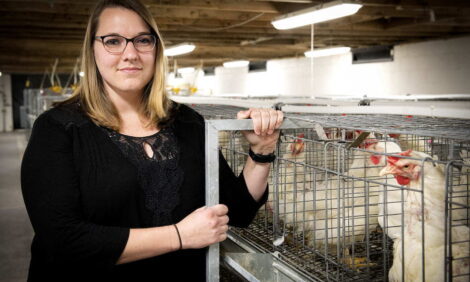



Reconciling Maternal (Flock) Age and Chick Quality
Marleen Boerjan of Pas Reform explains how the age of the female breeder can affect chick quality.The expression ‘chick quality’ is a general term, often used by hatchery managers to describe the appearance of a batch of day-old chicks. In this context, chicks deemed to be of ‘good quality’ are active with closed navels, a soft, smooth yolk sac, no red hocks and a clean beak. In such a batch, the birds are uniform in appearance and weight.
 |
A main cause of non-uniform day-old chick quality is variability in the quality of hatching eggs. Day-old chick weight and quality is determined by flock age, with factors such as strain (genetic background) and weight loss during incubation also influencing the overall quality of the chicks.
Genetic selection for growth, lean meat and FCR is negatively correlated with reproductive efficiency. The management of broiler breeders to optimise the production of good quality hatching eggs is therefore more challenging now than in the past. Uniform egg size depends on flock uniformity – and therefore on pullet growth management, nutrition and lighting schedules.
As the flock ages, we see an increase in the weight of the eggs it produces and consequently, an increase in recorded day-old chick weight (Table 1). An experienced hatchery manager knows that the quality of chicks will decrease when eggs are derived from aged flocks. This is often observed in higher numbers of chicks showing a bad navel and red hocks in batches from flocks older than 50 weeks. Poor chick quality as the flock ages is also recognised by slower growth during the first week (table 1) or when evaluating the morphological parameters used to calculate the Pasgar©score for chick quality (figure 1).
| Table 1. An example of production parameters related to age of broiler breeders | ||||||
| Age of Cobb broiler breeders (wk) | Egg weight(g) | Chicks scored for high quality (%) | Day-old chick weights (g) | 7-d-old chick weights (g) | Relative growth up to 7 d (%) | |
|---|---|---|---|---|---|---|
| 35 | 66.4 ± 0.5 | 97.7 ± 1.3 | 45.2 ± 0.4 | 141.4 ± 2.0 | 206.9 ± 5.1 | |
| 45 | 70.6 ± 0.6* | 93.7 ± 2.2 | 49.4 *± 0.4 | 140.4 ± 1.8 | 185.5 *± 4.2 | |
| *Data significantly different (P<0.05); Data from Tona et al., 2004: J. Applied Poultry Research 13:10 | ||||||
The exact reason why day-old chicks from older flocks are of reduced quality is not known, but it is most likely to be related to inadequate egg content and/or improper incubation conditions and/or pulling times. For example, in the routine of a hatchery, incubation times may not be adjusted to variable flock age. This may result in chicks that are too ‘fresh’ from very young (29-week-old) flocks and very old (59-week-old) flocks, or dehydrated chicks from flocks in peak production, since chicks from very young and very old flocks hatch later than chicks from peak production flocks.
Advice
- Incubate batches of eggs derived from one flock in one incubator whenever possible. When different batches of eggs must be combined in one incubator, try to ensure that the eggs are from flocks of similar age.
- Pull chicks according to flock age: chicks should be dry but not dehydrated. Pulling time is correct if five per cent of chicks are still a bit wet, i.e. with down feathers that are not completely dry at the neck.
- Evaluate chick quality using a quality-score system such as the Pasgar©-score;
- Adjust the incubation programme if chick quality is below your reference.









